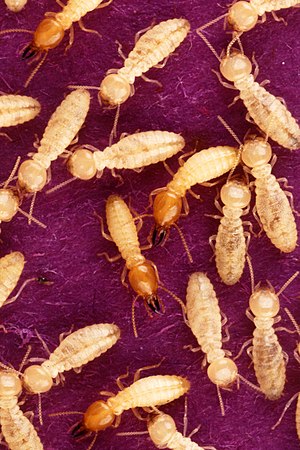Termites
Termites self-organize horizontally in a process biologist Pierre-Paul Grasse termed stigmergy, as Kevin Carson explains:
"'Stigmergy' is a term coined by biologist Pierre-Paul Grasse in the 1950s to describe the process by which termites coordinate their activity. Social insects like termites and ants coordinate their efforts through the independent responses of individuals to environmental triggers like chemical markers, without any need for a central coordinating authority."[1]
Ilya Prigogine and Isabelle Stengers describe the termite nest construction as an example of order emerging out of chaos:
The first stage in this activity, the construction of the base, has been shown by Grasé to be the result of what appears to be disordered behavior among termites. At this stage, they transport and drop lumps of earth in a random fashion, but in doing so they impregnate the lumps with a hormone that attracts other termites. The situation could thus be represented as follows: the initial 'fluctuation' would be the slightly larger concentration of lumps of earth, which inevitably occurs at one time or another at some point in the area. The amplification of this event is produced by the increased density of termites in the region, attracted by the slightly higher hormone concentration. As termites become more numerous in a region, the probability of their dropping lumps of earth there increases, leading in turn to a still higher concentration of the hormone. In this way 'pillars' are formed, separated by a distance related to the range over which the hormone spreads."[2]
An experiment summarized by Erich Jantsch displays termites' ability to creatively adapt to new circumstances:
The Austrian Nobel laureate Karl von Frisch (1974) reports in his wonderful book Animal Architecture the case of a termite nest which has been covered by a plastic tent, resulting in diminished ventilation. Within 48 hours, the animals had developed additional structures of a novel design which restored the old ventilation rate under the changed conditions.[3]
Marxist geographer David Harvey likens anarchist strategy to termite behavior. He critiques this strategy as ineffective or at least insufficient. Harvey's metaphor arguably overlooks that termites build structures as well as destroying them, and that termites can be quite resilient to extermination.
The assumption is that the oppressive power of the state can be "withered away" as oppositional movements of various sorts-factory occupations, solidarity economies, collective autonomous movements, agrarian cooperatives, and the like-gather momentum within civil society. This amounts to what one might call a "termite theory" of revolutionary change: eating away at the institutional and material supports of capital until they collapse. This is not a dismissive term. Termites can inflict terrible damage, often hidden from easy detection. The problem is not lack of potential effectiveness; it is that, as soon as the damage wrought becomes too obvious and threatening, then capital is both able and all too willing to call in the exterminators (state powers) to deal with it. The only hope then is that the exterminators will either turn upon their masters (as they have sometimes done in the past) or be defeated-a rather unlikely outcome except in particular circumstances such as those in Afghanistan-in the course of a militarized struggle. There is, alas, no guarantee that the form of society that will then emerge will be less barbaric than that which it replaces.[4]
- ↑ Kevin Carson, Exodus (Tulsa: Center for a Stateless Society, 2021).
- ↑ Ilya Prigogine and Isabelle Stengers, Order Out of Chaos: Man’s New Dialogue with Nature (Toronto: Bantam Books, 1984), 186-7.
- ↑ Erich Jantsch, The Self-Organizing Universe: Scientific and Human Implications of the Emerging Paradigm of Evolution (Oxford: Pergamon Press, 1980), 210.
- ↑ David Harvey, Rebel Cities: From the Right to the City to the Urban Revolution (London: Verso, 2012), 124-5.
